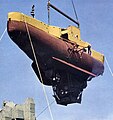FNRS-3
|
|
|
|---|---|
 FNRS-3 in Toulon |
|
| Construction and service time | |
| Keel laying: | 1950 |
| Launch: | June 1953 |
| Fate: | Decommissioned in June 1960, exhibited in Toulon since then |
| Technical specifications | |
| Length: | 16 m |
| Width: | 3.3 m |
| Height: | 7.8 m |
| Net weight: | 28.6 t |
| Payload: | 1,450 kg |
| Crew: | 1 pilot, 1 observer |
| Drive: | 2 electric motors with 0.75 kW each 1 propeller 2 maneuvering propellers |
| Speed: | Max. 1 kn |
| Sea endurance: | 24 hours |
| Diving depth: | 4,500 m (service) 16,000 m (theoretical maximum) |
| Pressure hull | |
| Diameter: | 2.2 m |
| Material: | Steel in the arc process |
| Wall thickness: | 90 mm |
| Weight: | 10.5 t |
The FNRS-3 was a French bathyscaphe that entered service in 1953 and briefly held a depth record.
The starting point for the development was the previous construction FNRS-2 , with which Auguste Piccard, in cooperation with the French Navy , had undertaken diving attempts near Cape Verde in 1948 . This design still had numerous shortcomings, had been damaged in heavy seas and was decommissioned in 1950. In the same year, the French Center national de la recherche scientifique (CNRS) signed a contract with the Belgian Fonds National pour la Recherche Scientifique (FNRS) for the continued use of the pressure hull of the FNRS-2. Planning for a new bathyscaphe began under the direction of French naval officers. Georges Houot was also involved , while Piccard only worked in an advisory capacity and withdrew completely from 1952.
In 1953 the submersible was launched in Toulon . Compared to its predecessor, there were many constructive innovations, above all the larger and streamlined buoyancy body in the shape of a boat. Furthermore, entry into the pressure hull was now via a shaft laid through the buoyancy body so that the crew did not have to get in before the vessel was launched. However, some important features have also been retained, including the electromagnetic suspension of the emergency ballast . This mechanism would have thrown lead weights in the event of a power failure in the on-board network, since the electromagnet would also have failed and the boat would have automatically returned to the surface.
After the launch, in August 1953, diving attempts were made in the Mediterranean , with the crew consisting of officers Houot and Willm reaching depths of up to 2,100 m. In 1954, diving attempts were made off the coast of West Africa, and the FNRS-3 reached a depth of 4,050 m near Dakar on February 15 . This broke the previous record in which Piccards Trieste reached a depth of 3,050 m off the island of Ponza in the Mediterranean on September 30, 1953. The FNRS-3 record was valid until 1959, when the Trieste reached 7,320 m.
The FNRS-3 was in service until 1960 and undertook expeditions to Japan and a total of 40 dives accompanied by several carrier ships. The marine biologist Théodore Monod also took part in diving trips with the vehicle . In 1960, FNRS-3 was replaced by the improved Archimède construction and has since been exhibited in the Toulon Naval Arsenal.
See also
literature
- N. Gierschner: diving boats . VEB publishing house for traffic / Interpress, Berlin 1980.

